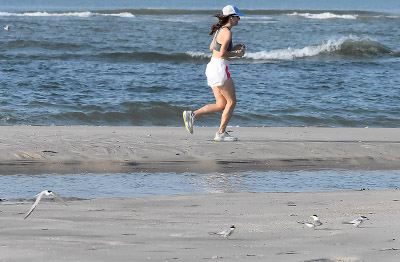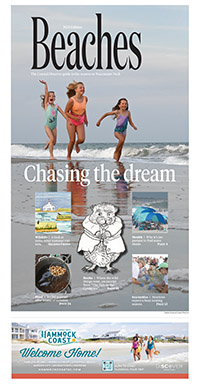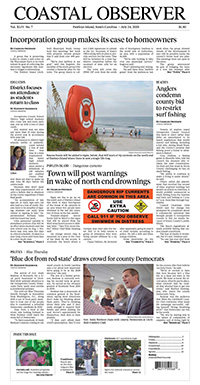Environment
Halfway through hatching, new seabird colony faces busy holiday weekend

The least tern nests on the southern tip of Litchfield Beach must go through one last test to make it through the season: the Fourth of July weekend.
“People don’t realize their effect on wildlife,” said Mary-Catherine Martin, a wildlife biologist for the state Department of Natural Resources.
The colony at Litchfield is the second largest in the state with 113 nests. She expected to see more fledglings since almost half of the colony has hatched. “He’s got a big world ahead of him,” Martin said as she watched a fledgling through her spotting scope.
The fledglings leave the nesting area after a week of practicing plunge diving for fish with their parents.
“They’re flying well at this point,” Martin said. “They go out with the adults and are starting to learn how to figure it out for themselves.”
Least terns in a colony do not all lay their eggs at the same time.
Eggs that were laid back in May have hatched and Martin said there’s a new batch of 32 least terns incubating their eggs, which account for almost a third of the colony.
“There’ll still be birds here on the Fourth but it just won’t be the majority of the colony. There will definitely be, still, plenty of birds here,” she said.
The fledglings have a brown cap and dull beak compared to an adult least tern’s black cap and bright yellow beak.
“That’s what it’s all about is just blending in. You haven’t figured out how to be a least tern, and so it’s good to have camouflage because things are trying to eat you,” she said.
A main factor in the colony’s success was their adaptation to beach-goers who walk and ride bicycles along the shore just feet away from the nests.
When least terns sense danger, the adults soar above the area to alert the others, which triggers a group effort to attack predators.
Being on high alert is dangerous especially for the adult terns incubating eggs since they’re left with no choice but to leave them exposed to possible avian predators.
Martin said it’s a good sign that Litchfield’s colony seems settled. Her best advice to ensure people don’t disturb the birds is to stay on wet sand.
“The birds are adapted to people well enough. As long as you’re not walking right through them, if you give them some space, they just kind of sit,” she said.
Martin has been the unofficial steward for Litchfield’s colony since she’s started watching them in May. She’s concerned about the impact fireworks will have on the colony this weekend. Martin contacted Audubon who has a couple of interested stewards to keep an eye on Litchfield terns and now they’re working on a schedule.
“Fourth of July will be critical. If people just leave them be, it won’t be that much longer,” Martin said as she expects the birds to be gone by mid-July. “We’ve got time to make a plan.”
Volunteer stewards spend weekends monitoring the least tern colony at Huntington Beach State Park.
Sharon Eisenzopf has driven from Myrtle Beach for the last four years to keep an eye on the birds. A friend told her about the ongoing program at the park to protect shorebirds and seabirds.
“I love birds. I didn’t really know a lot about shorebirds. It’s all just continuing education on my part,” she said.
As a steward, it’s her job to educate others.
Martin’s approach starts with a smile before keeping beach-goers away from the nesting birds.
“You can tell immediately when people don’t want to be bothered,” she said.
A Virginia couple told Martin they got close to the Litchfield nesting area “to see what the sign said.” The colony has a string fence on 30 wooden posts around it with signs with some information about the least terns.
Eisenzopf takes a similar approach, except she sets up a beach chair and an umbrella with a sign that reads “ask me about the birds.”
Most people are respectful about the interaction, she said.
“We just kind of talk to them, inform them about the birds. A lot of people know, which is interesting, because there are some locals and they come there a lot,” Eisenzopf said. “If you don’t respect it, it’s going to go away.”
Huntington Beach’s initial colony of 30 nests has produced eight fledglings with the rest being made up of chicks, according to Mike Walker, the park’s interpretive ranger.
The state park’s effort to train mammals to stay away from the nesting area includes electric fencing around the colony that is baited with sardine smoothies and bottle caps with apple-scented cotton to keep deer, raccoons and other predators away.
“They might be small but they will fiercely protect their eggs,” Martin added.




